I'm trying to find a precise definition for the transit time parameter in SPICE diode model. What I think is the official documentation for standrad Berkeley SPICE diode model says the following
Diode Model (D)
The dc characteristics of the diode are determined by the parameters IS and N. An ohmic resistance, RS, is included. Charge storage effects are modeled by a transit time, TT, and a nonlinear depletion layer capacitance which is determined by the parameters CJO, VJ, and M. The temperature dependence of the saturation current is defined by the parameters EG, the energy and XTI, the saturation current temperature exponent. The nominal temperature at which these parameters were measured is TNOM, which defaults to the circuit-wide value specified on the .OPTIONS control line. Reverse breakdown is modeled by an exponential increase in the reverse diode current and is determined by the parameters BV and IBV (both of which are positive numbers).
It only says that Charge storage effects are modeled by a transit time. But how are this charge storage effects exactly modeled?
I believe this parameter models the time it takes for the diode to switch from the on to the off state. Simulations seem to agree with these. However, I would like to have a more precise definition, linking this parameter to some physical value of the diode, or at least have a reference of what it is modeling.
I couldn't link it to terms used in literature. For example, in basic diode physics book, when talking about on-off transients, there is a storage time and a recovery time. Following image is taken from Semiconductor Physics And Devices
Storage time ts is defined as "time required for the minority carrier concentrations to reach equilibrium state". During this time diode voltage is constant, and recovery time t2 would be the time it takes for the diode to reach its reverse-biased current.
Then, total turn off time would be ts+t2. This time clearly depends on the forward and reverse currents imposed by the external circuit, apart from physical diode parameters like minority carrier lifetime. If transit time models this total turn off time, is it just an order 0 approximation to the real turn off time?
